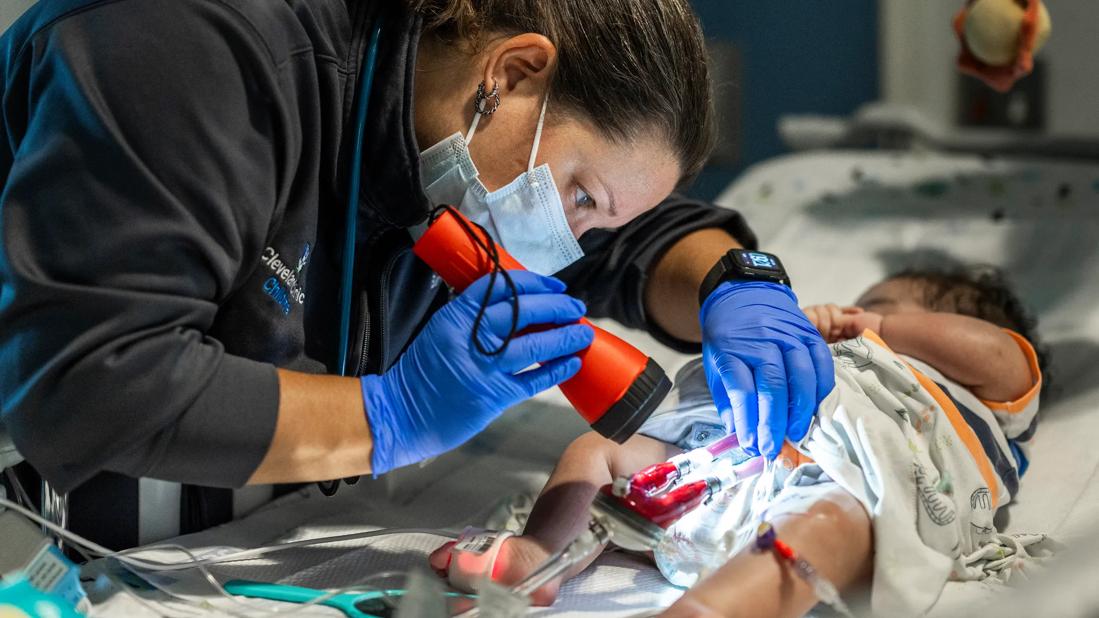Scoring tool and line rounds key to success

In 2020, healthcare facilities nationwide reported 21,399 central line-associated bloodstream infections (CLABSIs) to the Centers for Disease Control and Prevention’s National Healthcare Safety Network. Nurses throughout the Cleveland Clinic health system continually strive to prevent CLABSIs, which can prolong hospital stays, increase mortality rates and escalate healthcare costs.
Advertisement
Cleveland Clinic is a non-profit academic medical center. Advertising on our site helps support our mission. We do not endorse non-Cleveland Clinic products or services. Policy
“Our nurses are aware not only of the cost of care of a CLABSI, but also the high mortality rates associated with these infections,” says Michelle Schill, MS, BSN, RN, HACP, Quality Director at Cleveland Clinic Hillcrest Hospital. “They take each and every infection to heart. Vigilance in following established clinical practices to prevent CLABSI is not only essential, it’s an expectation.”
In 2021, Hillcrest nurses launched an A3 continuous improvement project to build upon a previous CLABSI reduction initiative. The initial program increased awareness about central line-associated bloodstream infections, and the A3 project shifted the focus to improving patient outcomes.
Stopping Healthcare Infections Now and for Eternity (S.H.I.N.E.), an enterprise-wide process confirmation initiative, was rolled out at Hillcrest in 2019. Each nursing unit used a visual management board for CLABIs that included squares for every room on the unit. The board was accompanied by two-sided cards. The front, which listed key points from Cleveland Clinic’s CLABSI bundle covering central line insertion, maintenance and monitoring, served as a reminder to clinical nurses. The back was solid red or green.
As part of S.H.I.N.E., nurse auditors rounded on patients with central lines three times a week to check whether bundle components were completed. For example, they checked whether the dressing was dry and intact and if tubing was labeled. If something in the bundle was missing, the auditor placed the card red side up on the visual management board in the corresponding room square. If everything looked good, they placed the green card on the board.
Advertisement
“It provided a visual reminder to staff, in real time, that something needed to be addressed,” says Schill. After rounding, nurse auditors met one-on-one with clinical nurses to point out any issues that needed attention, such as a dressing change. The same process was used for catheter-associated urinary tract infections (CAUTIs).
During the COVID pandemic in 2020, there was an uptick in CLABSI events so RN Program Coordinator Ashley Matz, BSN, RN, spearheaded an A3 project to ascertain the root cause for the increase and implement preventative strategies. Some of the elements of S.H.I.N.E., such as the visual management board and audits, were adapted and retained. Others were added.
Components of the new process include:
Advertisement
In addition, nurses were re-educated on central line care and maintenance.
Matz says the new process has changed the nursing culture, encouraging caregivers to speak up for patient safety and collaborate with providers.
Grace Davis, BSN, RN, Nurse Manager on the Trauma, Orthopedic and Neurosurgery Unit, adds that the necessity scoring tool allows nurses to drive changes in care and patient outcomes. “Nurses like the 1, 2, 3 scoring model. It serves as a discussion point with peers and providers and lets them know if they are on the right track,” she says. “It increases the confidence of the nurses and empowers them to advocate for better outcomes.”
Implementation of the new process in August and September 2021 has made a difference. “We track the number of lines in nursing huddles every day, and they have decreased even though our census has not,” says Schill. In addition, Cleveland Clinic Hillcrest Hospital had zero CLABSIs in October and November.
“We are getting central lines out faster, which ultimately is safer for the patients,” says Matz. “Our goal is to embrace the culture of none by decreasing mortality and central line infections.”
Advertisement
Advertisement

Nurses harness cutting-edge technology as a bridge to healing

Project aims to improve patient care by streamlining caregiver transitions

Optimizing care while protecting patients from life-threatening reactions

Palliative nurses improve quality of life

Strong bonds and momentous milestones fuel life-changing work

Experts offer hands-on support and education

Special skills course aims to improve patient safety and comfort while building caregiver confidence

Bariatric nurses deliver sensitivity, compassion and skill